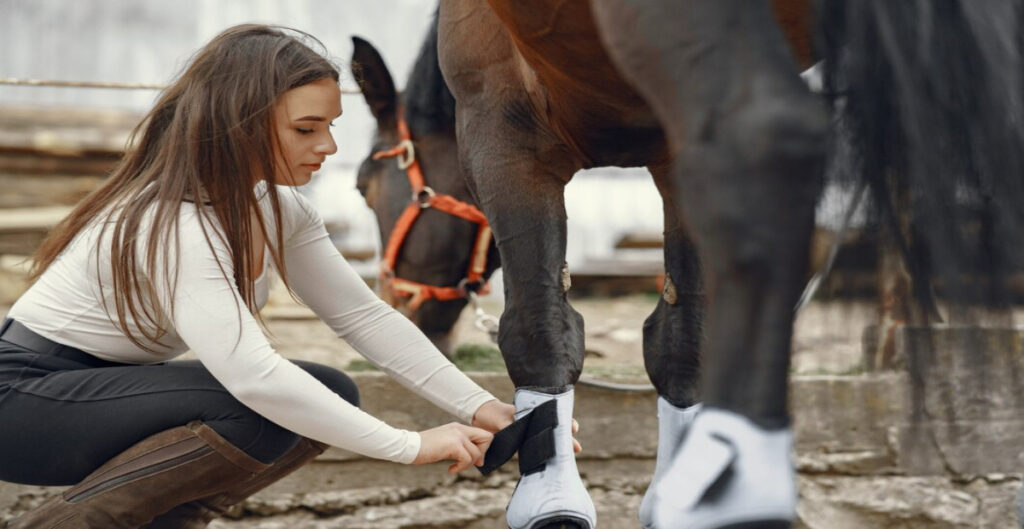
For many horse owners, maintaining joint health is a common issue, regardless of whether the horse is a foal, a broodmare, an adult horse or a senior horse.
Preventative measures can protect your horse from joint problems that impair performance, comfort or general well-being.
Although diet is an important factor in maintaining the health of your horse’s joints, there are other ways to strengthen and maintain joint function.
A joint is the point where two bones come together, joined and covered by cartilage and connective tissue. A vital component of joint function, synovial fluid serves as a lubricant within the joint. When combined, they absorb load and allow mechanical movement.
In the womb and during development, horses create and develop their joints. Although it cannot ensure that injury or illness will not occur, promoting good growth in the foal can be a critical factor in preventing joint problems.
Cartilage turnover decreases with age. Joints can become vulnerable to injury when high-intensity activity, loading and general wear and tear combine.
Osteoarthritis can be caused by joint degeneration. Proinflammatory mediators, including interleukin-6 (IL-6) and tumor necrosis factor-alpha (TNF-α), can cause inflammation. Oxidative stress in the joint can also be detected by oxidative markers such as prostaglandins.
It is possible to support joint health at any age. These are the eight guidelines provided by the Mad Barn to promote healthy horse joints.
Top 5 principles for joint health in horses

Make sure you eat right
Among the most important things you can do to help your horse develop and maintain healthy joints is to feed them a complete and balanced diet.
For a horse to maintain healthy bones, cartilage and synovial fluid, its energy needs must be met in addition to providing enough protein and the right kinds of vitamins and minerals.
More calories or energy may prevent growth from slowing or stopping. This can lead to weight loss, particularly muscle tissue, in mature horses, increasing the likelihood of injury.
The dangers of too much energy
Overeager horses may experience developmental problems during growth and develop excessive body weight.
Based on the 1989 National Research Council – Nutrient Requirements for Horses, foals showed signs of dyschondroplasia when fed a diet of mostly roughage at 129% of their daily energy requirements for 16 weeks.
Abnormal growth of cartilage that can affect bones and joints is known as dyschondroplasia. Building and maintaining healthy joints requires providing enough energy, but not overeating.
Amino acids
A complete amino acid profile for proteins is essential, with particular emphasis on lysine, methionine and threonine.
These are essential for general health and the most commonly limiting amino acids in a horse’s diet. Protein synthesis will be hindered in your horse if certain critical amino acids are not supplied adequately, even if total protein requirements are met.
Vitamins and minerals
Your horse’s joint health depends on many vitamins and minerals, including calcium, phosphorus, zinc and copper.
The two main minerals found in bones and joints are calcium and phosphorus, which must be present in adequate amounts during development.
Inadequate calcium intake in older horses will cause the bone to lose calcium, reducing bone structure and integrity.
Although it can be as high as 3:1 in foals, a calcium to phosphorus ratio of 1.5:1 is considered optimal.
Zinc and copper are essential for the synthesis and maintenance of collagen. However, excessive amounts of these minerals can interfere with or compete with other minerals for absorption. If the diet is not very varied, it may not be easy to get enough of these trace elements.
By sending your horse’s food for testing, you can be sure that it is being fed a complete and balanced diet. Our equine nutritionists are available to discuss the unique requirements of horses and recommend the best feeding program.
Exercise your Horse
Low impact exercise can help your horse develop stronger bones and increase the composition and quantity of cartilage and synovial fluid. It has been shown that children who exercise have better cartilage thickness and composition than those who do not.
Two-year-old horses were trained for thirteen weeks on grass and sand tracks, and the horses’ articular cartilage thickened in various joints.
The horses trained in the study by Firth et al. had thicker hyaline cartilage than untrained 2-year-old horses.
Additionally, stalled horses synthesized significantly less proteoglycan than horses exercised for six weeks.
These findings make it abundantly clear that frequent, low-intensity exercise in horses promotes bone and cartilage growth and joint health.
Do not miss the preparation and switch to high-intensity exercise
As mentioned earlier, exercise is vital to keeping joints strong and healthy. On the other hand, introducing your horse to high-intensity training too early without giving his body time to adjust can lead to joint injuries and the onset of joint diseases such as osteoarthritis.
Early in life, gentle exercise should be included. During the first five months of life, foals kept in stalls showed abnormal bone growth. On the other hand, daily galloping sprint activity caused overstimulation of bone growth.
According to the study, foals with unlimited access to pasture during their first five months of life developed their bones at their ideal rate.
Consider gradually introducing high-intensity training to your horse. Increase the duration and intensity of your workouts over a few weeks or months, starting with low-intensity activities like walking.
Your horse’s physique will adapt to the increased demands and help protect the joints from damage.
It is essential to consider the type of activity and any repetitive movements that can stress your horse’s joints. A joint injury is likely to occur from excessive force applied to the joint repeatedly.
Welcome!
The “Next Page” button will appear after 20 seconds.
